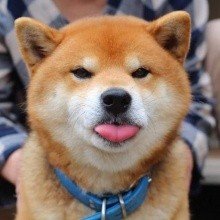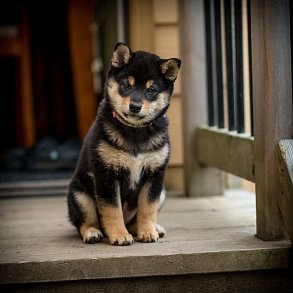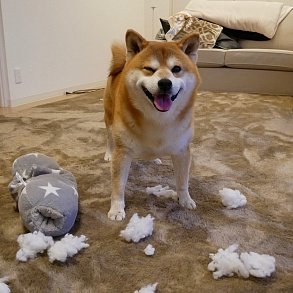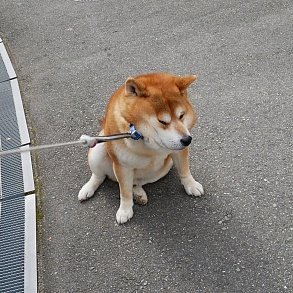Shiba Inu

Shiba Inu is a charming dog with plush fur and a wayward character. Being the owner of such a pet is not easy, but if you win his respect and trust, you will get a lot of pleasure from communicating with an intelligent and inquisitive friend.
Brief information
- Breed name: Shiba Inu
- Country of Origin: Japan
- The time of the birth of the breed: III century BC
- Weight: males 9-14 kg, females 8-13 kg
- Height (height at the withers): males 40 cm, females 37 cm
- Life expectancy: 12-15 years old
Highlights
- Animals of this breed are distinguished by high intelligence and strong character.
- Shiba Inu are terrible owners, categorically do not like to share.
- Dogs are very clean, deliberately avoid dirt, carefully lick themselves.
- Shiba Inu are difficult to train, pretend to be a leader and constantly check the owner for strength.
- One person is recognized as the leader, they keep their distance with the rest.
- Puppies require early socialization, otherwise the dog is not amenable to education.
- Avoids physical contact, is sensitive to personal space, actively protects it.
- Sibs are very inquisitive, active, and become excellent companions in traveling and playing sports.
- Shiba Inu does not get along with kids, the breed is recommended for children over 10 years old.
Shiba Inu is a hunting dog bred in Japan. Its history goes back about two and a half thousand years. Modern representatives of the breed often act as companions. Inquisitive and friendly disposition allows them to get along well with the owner, but the animals are wayward, require competent training. Since 1936, Shiba inu has been recognized as the property of Japan. Integral character, high intellectual level and special strength of spirit made these animals popular among dog breeders. Being the owner of such a pet is not easy, but if you win his respect and trust, you will get a lot of pleasure from communicating with an intelligent and inquisitive friend. The breed is suitable for experienced dog handlers, but as the first dog, the Shiba Inu with its complex disposition is not the most successful option.
Breed characteristics
History of the Shiba Inu breed
Archaeologists have found the remains of dogs of a similar type dating from the 4th-3rd centuries BC. The Shiba Inu breed belongs to the group of spitz, has all the characteristics inherent in them: sharp erect ears, a special shape of the tail, thick two-level wool. According to experts, the ancestors of the shiba Inu were brought to the Japanese islands from China or Korea, and already in the course of crossing with the aborigines, the existing standard was formed. Being a close relative akita inu , siba are characterized by smaller sizes. The kinship of the breeds is confirmed genetically.
Until the middle of the XIX century, Japan was a closed country, and shiba inu was bred only in this territory. With the overcoming of isolation, the dogs got to Asia and Europe, where dog handlers appreciated the sharp mind and excellent hunting qualities of the animals. To improve these characteristics, breeders began to practice active crossing of siba with pointers and setters. The lack of a standard and haphazard breeding led to the loss of the breed, it almost completely disappeared within the city limits. By the beginning of the XX century, leading dog breeders were engaged in the problem of shiba inu. Native species have been preserved only in remote rural areas, they have become the basis for the restoration of the tribal gene pool.
In 1928, it was decided to take measures aimed at preserving the purity of the breed and restoring its numbers. The main selection criteria were standing triangular ears, deep-set eyes, dense two-level coat and tail, steeply twisted behind the back.
By 1934, dog handlers managed to form standards and isolate the breeding skeleton. In 1936, the breed was declared a national treasure of Japan, breeders in the historical homeland of the Shiba Inu prevented the extinction and degeneration of animals. The Second World War had a negative impact on the gene pool: many dogs died, kennels suffered during the hostilities. After the establishment of peace, systematic work on the restoration of the breed started again. Epizootic complicated the situation: an epidemic of distemper broke out, which significantly reduced the ranks of the four-legged.
The pre-war breed included dozens of varieties of shiba, the cataclysms that happened left only three subtypes in sufficient quantity for breeding: mino, san-in and shin-shu. Being a native Japanese breed, the modern shiba Inu is the result of directed breeding of these animals.
The first branch had the greatest influence on the formation of the shiba inu: they have a similar exterior of the ears and tail. Dogs are related to shin-shu by a reddish-sandy coat color, the structure of the guard hair and a fluffy undercoat. From the san-in, representatives of the breed took a massive skeleton and the structure of the trunk, but the shiba-inu is smaller in size. The resulting hybrid has gained wide popularity among the Japanese. In conditions of dense urban development, this animal with its small size and decorative exterior has become a favorite of many families.
By the beginning of the 80s, the breed was widely spread abroad, and in 1992 it was recognized by the American associations AKC and UKC. Thick fur, unusual fox appearance, sharp mind, activity and curiosity are not a complete list of advantages that allowed the shiba inu to gain enviable popularity among breeders. Today, her role as a hunter has receded into the background, pushing the duties of a companion to the main role.
Video: Shiba Inu
Appearance of shiba inu
The Shiba Inu has a strong backbone, is harmoniously built, the endurance and massiveness of ancestors who had to spend many hours hunting are visible in the general constitution. Representatives of the breed have strong paws of medium size, a triangular head, similar in shape and location of the eyes to a fox.
Dimensions
Males at the withers range from 38-41 cm, weight ranges from 9 to 14 kg. Females are smaller, the height of individuals is 35-38 cm, weight from 8 to 13 kg. The Shiba Inu dog is well balanced, lean, the tail is wrapped in a ring on the back.
Head
The flat forehead is more often with a longitudinal line, the muzzle is thickened at the base, it is pointed closer to the nose, the shape and color resembles a fox. The eyes of the shiba inu are small, close-set, have a slight slope, as a rule, brown. Standing ears are a distinctive feature of the siba, they are dense to the touch, slightly turned forward, with a characteristic triangular shape. The animals have a strong muscular neck, emphasizing the solidity of the figure. A scissor bite and solid good teeth are characteristic. Nose with a straight back, mostly black color.
Housing
The dog is massive, predisposed to prolonged loads, has good health and endurance. A straight and strong back ends with a muscular lower back. The breed is characterized by a moderately wide chest, an average bend of the ribs, and a lean belly. All parts of the body of the shiba Inu are harmonious in size, individuals have a strong and lively constitution.
Limbs
The paws of the shiba inu are proportional to the body, sufficiently dense and large, of medium length. In the forelimbs, the shoulder blades have a moderate slope, the elbows are located closer to the body, oriented strictly backwards. An active lifestyle has clearly affected the hind legs, they have developed muscles, elongated hips and short shins. The high mobility of the shiba inu is explained by massive hock joints, the softness of the forms is preserved by moderately pronounced angles of articulation. The paws are characterized by good elasticity, the claws are predominantly dark in color, the fingers are tightly compressed, they protrude in relief.
Tail
The tail is one of the important criteria of the Shiba Inu breed. It is twisted into a well-defined ring, set high, can reach the hock joint in length, covered with dense hair, thick enough.
Color
There are three main types of shiba inu color: red, zonal or sesame, black with silver or red markings. A mandatory component for participation in exhibitions is the urazhiro – a special pattern that creates a lighter coat in the area of the cheekbones, neck, lower chest, abdomen. Lighter areas should also be located on the inner surface of the paws and the lower part of the tail.
The gradation of sesame color is interesting, there are three main directions:
- red sesame (or sesame) is a mixture of red and black hair, more often red hair with a black edge;
- black sesame – black wool predominates over a small number of light hairs;
- sesame (sesame): equal number of black and white hairs.
The breed's marriage is considered to be too light color, sandy and white shades. The most desirable bright red, rich and rich color.
Wool
Dense and two–level wool is a real decoration of the shiba inu. The soft and thick undercoat gives the dog a special charm. The second layer is represented by a stiff outer hair, it is straight, significantly raised above the undercoat.
Disqualifying defects
Special attention is paid to the color of the shiba inu, individuals of light sandy color, cream and white are not allowed to the exhibition. Also, an urazhiro is required for exhibition copies.
The disqualifying factor is the sagging of the ears, this characteristic is one of the leading ones in the identification of the breed. The shape and size of the tail are important: its insufficient length will not allow the pet to participate in competitions. Defects also include its sagging, the absence of a characteristic bending ring.
Compliance with the size of the standard is important: small males and bitches corresponding to the size of males are not allowed to exhibitions. Much attention is paid to the oral cavity, the absence of a large number of teeth will cause disqualification, and the dog should not have an undershot or overbite. Cowardice and aggressiveness are unacceptable from the behavioral features of the Shiba Inu.
Photo of an adult shiba Inu
Character of shiba inu
Shiba Inu has a strong and self-willed character, the dog requires a firm hand and a confident owner. Prone to dominance, she will always check whether the leader's place is vacant and try to take it. The animal is characterized by an average degree of activity, it is quite adapted for living in an apartment in a megalopolis. However, the dog will feel most comfortable with an active owner who loves regular physical activity. The dog prefers long walks and will be an excellent companion in nature hikes.
The Shiba Inu breed belongs to the primitive, so the representatives have very strong instincts developed over centuries of evolution. Even well-bred trained individuals in the heat of hunting completely forget about the owner, do not hear commands, which is why experienced dog handlers recommend walking the shiba Inu only on a leash in order to avoid unpleasant situations.
Pets are very sensitive to personal space, behave like avid owners. When an attempt is made on their belongings and food, they are able to show aggression, actively defend their position. Sibu is not recommended for families with young children, because violation of the boundaries of the animal can lead to negative consequences. Dog handlers recommend bringing a dog of this breed to a house where children are over 10 years old.
Due to the possessive nature of the shiba inu does not get along well with other pets, the desire to dominate and the constant struggle for resources will lead to conflicts and bullying of the second pet. It is important to remember that Shiba inu is primarily a hunter, so everything that can be caught and eaten. He treats cats as prey, so there is a high probability that the second pet will be slaughtered.
Having a bright and independent character, representatives of the breed, as a rule, choose one owner and obey him. Dogs are smart and cunning, if necessary, they will defend their own interests in all ways, so the owner must understand the animal well and be able to handle it competently. Physical violence is absolutely excluded, an aggressive approach negatively affects the psyche of the Shiba Inu, makes the dog unbalanced and angry.
The breed is not recommended for beginners, animal training requires patience and experience, so even an experienced breeder makes sense to seek the help of a dog handler who knows how to work with siba. The dog is independent, distrustful of strangers, keeps them at a distance, it needs time to get to know and accept a new person.
Like their progenitors, wolves, Shiba inu are extraordinary owners. Their place on the sofa, ball, bowl, owner, yard is taboo for other animals and people. If necessary, the animal actively goes into conflict, protects its belongings. When planning to take a puppy, you need to be prepared for such situations.
Education and training
Because of the peculiarities of the character, raising a Shiba inu is not an easy task. It is important for the owner to establish and constantly maintain authority. An inquisitive and active disposition often pushes dogs to mischief, but it is quite difficult to punish a shiba inu. Power methods of education are unacceptable, and the pet tries in every possible way to neutralize the psychological effects of behavior. Possessing a bright charisma, siba can reproduce a variety of sounds, in her arsenal creaking, whining, squealing, grunting and even croaking. And a branded smile can melt the heart of even a very strict owner. The dog actively uses the whole set of techniques to avoid punishment, perceives cases of loss as a tactical failure, looking for ways to insist on his own.
Training requires a lot of patience and understanding of the characteristics of the breed. So, if the dog is carried away by some kind of smell, it is almost impossible to get attention from her. Experienced dog handlers actively use the curiosity of the animal, turning the learning process into a game. High intelligence allows the shiba inu to solve even very difficult tasks, but the wayward nature is often an obstacle to full-fledged training.
It is important to understand that animals have a negative attitude to personal contact, have possessive tendencies and are very freedom-loving, therefore, from an early age, shiba inu needs to be educated and socialized. Adult untrained individuals are difficult to train, do not tolerate tactile contact. This breed will be an ideal companion for strong charismatic people who are confident and understand what they want from life.
Hardy and active, siba will be happy to do coursing, dog frisbee, canine freestyle, agility.
Care and maintenance
Although dogs of this breed are not picky about food, the food should be balanced and contain all the necessary elements. Given the origin of the animal, the shiba inu diet necessarily includes fish, seafood, rice and algae. Wheat, corn, chicken and beef are given with caution – these products can cause allergies. Eggs, smoked meats, chocolate and sweets are strictly prohibited, they negatively affect the digestive tract and vascular system of the dog. The shiba inu diet can be enriched with vegetables. These pets do not eat much, so special attention should be paid to the quality of the feed.
Wool
A thick coat with a dense undercoat requires care and maintenance. It is usually enough to comb the animal once a week, but during the molting period, the procedure is necessary every day. It is more expedient to carry it out on the street, combing is performed against the growth of wool, so it is easier to remove hair and stimulate blood flow to the skin.
The shiba inu cover has water-repellent properties, and the dog itself is very clean, so it is bathed no more than once a month. After a walk, it is enough to wait until the wool dries out, and the dirt will crumble by itself. The animal actively licks itself and for the love of cleanliness can quite compare with a cat.
Eyes
The Shiba Inu breed is genetically predisposed to eye diseases (retinal atrophy, eyelid inversion, cataract, conjunctivitis), therefore daily monitoring of the condition is necessary. A healthy individual has clean, shiny eyes, without extraneous secretions. Morning lumps after sleep are acceptable, they should be cleaned with a soft wet cloth. If the dog has already had cases of conjunctival inflammation, it is necessary to rinse the eyes with chamomile decoction once a week. With the appearance of swelling, purulent discharge from the lacrimal lake, redness of the eyelids, the help of a veterinarian is urgently needed.
Ears
Dog ears need a weekly examination, if earwax accumulates, it must be removed with a wet swab. Healthy ears are dense, of a pleasant pink color, without extraneous inclusions. If the dog shakes his head, constantly scratches his ears, excessive discharge is observed – all this is an excuse to contact the veterinarian.
Paws and claws
Shiba inu claws require pruning no more than once a month, they need to be additionally filed to avoid burrs. If the plates are too hard and do not lend themselves to pliers, you can hold the pet's limbs in warm water.
Paws require inspection after each walk, possible abrasions and cuts are treated with antiseptics, pads are washed with warm water. If the skin is dry and cracking, you need to additionally lubricate it with oil.
Ticks and fleas
The thick and dense coat of the shiba inu is a great place for exoparasites, so special attention should be paid to sanitation. Inspect the dog after each walk for ticks and other insects. A visit to the veterinarian is necessary even if infected with banal fleas: only a specialist will be able to correctly select a set of treatment measures taking into account the weight and age of the dog.
Helminths
Shiba Inu, like other purebred dogs, needs regular anthelmintic measures. Adults undergo the procedure 4 times a year, in puppies the treatment is associated with the schedule of vaccinations.
Health and diseases of shiba inu
The Shiba Inu breed is distinguished by excellent health, which is not surprising, given the history of its origin. The hardiest and strongest individuals were selected for hunting, and developed intelligence was encouraged. The animal has no characteristic genetic diseases, the average life expectancy of the siba is 15-16 years. A high-quality gene pool confirms the fact that Siba-inu is listed in the Guinness Book of Records as the longest-lived dog. Her age was 26 years old, and until the last days she remained active and inquisitive.
Among the most common diseases, disorders of the musculoskeletal system can be distinguished:
- dysplasia or underdevelopment of the hip joint;
- dissecting osteochondritis;
- dislocations of the kneecaps;
- the spine is shortened in comparison with the standard.
Shiba Inu is characterized by eye problems, the following disorders are common:
- retinal death with progressive development;
- entropion;
- inflammatory process of the vascular system of the eye;
- cataract.
Some individuals suffer from systemic diseases. Cases of Willebrand's disease (blood clotting disorder and spontaneous bleeding), thyroid diseases associated with a lack of hormone production were identified in Shiba Inu.
Representatives of the breed may suffer from pigmentation disorders, it manifests itself in premature graying, widespread vitiligo.
Special attention should be paid to the feed, since siba-inu have allergic reactions to products that are not characteristic of their diet. An unbalanced diet also affects the quality of wool, leading to its premature loss.
How to choose a puppy
You need to buy a pet from professional breeders. Before buying a shiba inu, it makes sense to drive directly to where the puppies live and develop. It is very useful to see the mother and, if possible, the father. Parents should evaluate the following factors:
- individuals must fit into the standard sizes provided by the floor;
- the presence of sharp, triangular, well-standing ears;
- there should be no culling by color, preferably the presence of urazhiro;
- the tail, twisted into a pronounced ring, without creases, reaches the middle of the joint.
Good genetics of parents determines the health and exterior of the future pet. If the bitch has already had offspring, it is worth asking about his photos, to assess how the puppy will look when he grows up. An additional bonus will be the fact that already grown individuals participate in exhibitions, have awards for the exterior. The presence of achievements in parents also indicates a good potential of children.
It is important that the Shiba Inu family is kept by the breeder at home. The socialization of puppies from birth determines their disposition, their ability to get along with people, the ability to get along with children. If the animals are brought up in an aviary, there are likely to be problems with adaptation and training.
Photos of shiba inu puppies
How much does shiba inu cost
The price of shiba inu depends on the class of the animal. If you plan to actively attend exhibitions, win places and conquer the world with the exterior, then you need a breed or show class individual. A good pedigree of the parents, promising personal characteristics of the puppy, a full package of documents – such a purchase will cost around two thousand dollars.
If you are looking for a new family member, an active playmate and traveling companion, you can pay attention to pet class animals. Their cost ranges from 300-500 dollars. They, as a rule, do not have documents, in some parameters they may fall short of breed standards.
The market also offers intermediate options, the cost of a particular individual is largely determined by its exterior and future prospects. The name of the breeder also influences the final price of the shiba inu: different nurseries form price offers individually. The prominence of parents is another factor that increases the cost of puppies.


